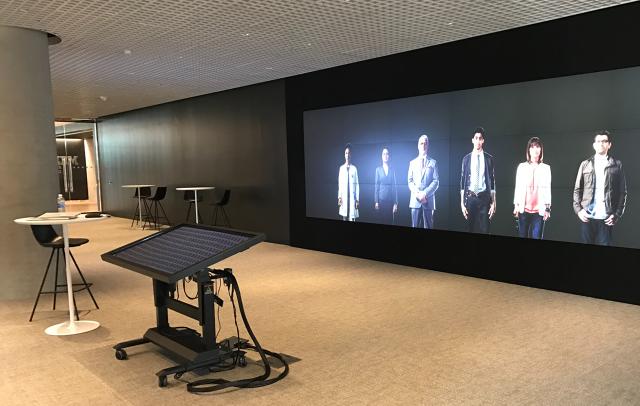IBM Goes West: A 73-Year-Long Saga, From Punch Cards To Watson
Next week, IBM is formally opening Watson West—a San Francisco outpost for its Watson “cognitive technology” platform, which the company is training to help everyone from doctors to merchants make smarter decisions. Occupying three floors of a gleaming office building in San Francisco’s startup-heavy South of Market neighborhood, the office includes both space for employees involved in the Watson effort and a slick demo center where IBM can whip up enthusiasm among third-party developers, prospective customers, and other outsiders.
Watson West is, in part, a statement about IBM’s desire to embed itself in the San Francisco Bay Area tech community. But it’s also less of a striking departure than the latest chapter in a long story. IBM may be the archetypal big East Coast tech company, but it’s understood the benefits of being at home in the Bay Area for decades, dating back to the era when it was a manufacturer of automation equipment, and the computer was still in the process of being invented.

IBM long ago shifted its emphasis from big iron to software and services. With Watson, it’s a key player in the race to use machine-learning technology to train computers to understand big data in an array of fields—an industry trend that, in one way or another, has also swept up everybody from Google to Facebook to Microsoft to Apple. “IBM has a lead on this, having started a couple of decades ago,” says Watson General Manager David Kenny, who is still a newcomer to IBM, having joined the company when it closed its acquisition of his former employer, the Weather Company, in January.
Computer scientists at the IBM Research-Almaden lab in San Jose were part of the AI research that made Watson possible in the first place and are helping to chart its future. Now, with Watson West, the company has a presence “at the top of the [San Francisco] peninsula as well as the bottom,” Kenny says.
That’s particularly important as Watson becomes the foundation for capabilities that can be commercially deployed in specific business sectors—a process that frequently involves startups who build on top of IBM’s work. “Many of those companies are on the West Coast and funded by VCs on the West Coast,” says Kenny.

Helping such companies work with IBM with as little friction as possible is key to Watson fulfilling its potential. “People can always travel, and people will travel for the most important relationships,” says Slack cofounder Stewart Butterfield, whose startup announced this week that it was partnering with IBM to let third-party developers build Slack chatbots powered by Watson intelligence. What you lose with distance is the ability to participate in forms of collaboration and community such as hackathons without giving it a second thought. “You can fly out over and over again for that kind of stuff, or you can be in the Bay Area and catch the action,” Butterfield says.
(In the case of the IBM-Slack collaboration, Slack happens to have search and intelligence staffers based in New York, which let them commute by foot to Watson headquarters in the city’s Astor Place neighborhood, eight blocks away. But some meetings—including ones involving Butterfield—took place in San Francisco.)
In The Beginning
When IBM first put down roots in Silicon Valley in 1943, the area was known for its bounteous orchards, not technology. The company bought a 34,000-square-foot factory in San Jose and began manufacturing punch cards for its tabulating machines. (The computer industry didn’t exist yet, though IBM was at work on research that helped create it.)
“Our decision to establish a plant on the Pacific coast is based not only on the large amount of business that we now have in the territory, but on our belief that after the war, the Pacific coast will be a far greater industrial district than ever before,” explained legendary CEO Thomas J. Watson Sr. It would take decades before it was clear just how prescient he was.
In 1952, the company added to its San Jose presence with a lab based in the city’s downtown area. Four years later, one of the industry’s landmark achievements happened there when a small team of researchers invented the hard drive, which the company used as part of an accounting computer called the 305 RAMAC.

At about the same time, as part of a push to raise its profile on the West Coast, the company broke ground on an ambitious, innovative 190-acre research/manufacturing operation located on land formerly devoted to walnut groves. In 2014, I wrote about this prototypical Silicon Valley corporate campus, including the strange story of Soviet premier Nikita Khrushchev’s visit in 1959. (He was more impressed by the cafeteria than the computers.)
In 1986, IBM Research’s San Jose arm moved into its current home, IBM Research–Almaden. Judged purely on the surrounding natural splendor—rolling hills, parks, and preserves—it may have the most beautiful setting I’ve ever seen for a tech-company office. But the location, at the southern end of San Jose, is not exactly convenient to the rest of Silicon Valley. You need to do a fair amount of driving to get to Intel (20 miles to the north), Apple (21 miles), Google (26 miles), and Facebook (33 miles).
That locale—proximity to the Valley’s ecosystem, but not too much proximity—is intentional, even though many of its biggest players didn’t exist back in 1986 when the Almaden office opened. “When the labs were first started, the idea was to place them near strong academic centers and strong centers of business and commerce, but not right in the middle of them, necessarily,” says Jeff Welser, the IBM VP who heads the Almaden operation. The original research center in Yorktown Heights, for instance, is about 40 minutes north of New York City.

“We wanted to be close enough in that we can interact and take advantage of everything there, but separated enough that we can actually also do our work in our own area,” says Welser. “Think deep thoughts, as our founder would say. In fact, actually at lunchtime, you’ll see people literally walking a loop around this lab because you get a beautiful view of the valley.”

The Almaden building does feel like a refuge where gifted scientists can squirrel up in their offices and put their brainpower to work without distraction, though it’s hardly antisocial. (An open area called THINKlab is specifically designed to facilitate collaboration between IBM clients and researchers with various areas of expertise.) IBM Research’s rich legacy testifies to the approach’s success.
“Historically speaking, large corporate research organizations have had varying kinds of success,” says Guru Banavar, VP of cognitive computing. “I would say IBM corporate research has been the most successful in terms of scale and impact.”
As the official IBM Research-Almaden timeline indicates, the facility’s three decades of history are a chronology of what was important to the company at any given point in time. Data—how to store it, retrieve it, and make it useful—has been an ongoing theme. In 1970, the relational database was invented there. In 1988, its researchers created a standard for speedier data recording on a disk. In 1998, as mobile devices gained in importance, the lab developed the Microdrive, a tiny hard disk. And in 2002, it proposed a database designed with protecting the privacy of personal data in mind.
Today, “If I had to sum up in a nutshell what this lab does,” says Welser, “it’s all about using data to expand what the human mind can do. That really is in essence what cognitive computing is about.”
Despite IBM Research-Almaden’s scholarly air, people are drawn here in part by the opportunity to create things that will be turned into businesses. “If you are someone who really wants to do academic research, you want to be a professor, you want to teach the next generation of students, a university is the right place to go.” Welser says. “But if you want to be able to do deep research and have that get translated rapidly into something in a very broad portfolio of potential application areas, that’s the kind of person that really likes IBM Research.”
Some of the most wildly ambitious of those efforts—ones of the sort that Google would call moonshots—are instigated by IBM’s Grand Challenges program. Watson itself originated as a Grand Challenge, back when the notion of training a computer to play Jeopardy better than a human champion sounded—at least to those of us who aren’t among the world’s savviest computer scientists—to be downright fanciful. That challenge was met. And now IBM researchers are leveraging Watson to tackle feats that could be far more meaningful than providing questions for Alex Trebek’s answers.
Welser defines a Grand Challenge as “something that, at this point, we don’t know if we can do or not, but if we could do it, it would make a huge difference to us, to our clients, to the world.” One such project, dubbed “the Medical Sieve,” aims to use cognitive-computing technology to analyze radiology images for signs of abnormalities such as aortic aneurysms.
The Medical Sieve exemplifies IBM’s philosophy that Watson is best used to help human beings make more effective decisions more quickly, rather than to eliminate humans from the decision-making process altogether. “A radiologist in a typical emergency room situation may look at as many as 100,000 images a day,” says Tanveer Syed-Mahmood, the IBM fellow who heads up the effort. “With that volume of imaging, they do have an overload in terms of high fatigue.” The Medical Sieve’s goal is to create an automated assistant that’s as skilled at analyzing images as an entry-level radiologist, thereby freeing up time for medical professionals such as cardiologists to focus on work that requires their advanced expertise.

Of course, a task that would be entry-level work for a person is a remarkable accomplishment for a computer. “It has to apply clinical knowledge,” says Syed-Mahmood. “It has to understand the appearance of organs in images and recognize them from different viewpoints. It has to reason with the information, know what the guidelines are, in order to cull this data, simplify it, and present it to the clinician.” A range of IBM experts in AI, image processing, and medical topics are collaborating on the effort, along with external partners such as doctors; in 2015, the company also acquired Chicago-based imaging company Merge Healthcare to aid in the effort.

Elsewhere in IBM Research-Almaden, other scientists are working on “brain-inspired computing,” a project—funded in part by the U.S. Department of Defense’s DARPA—to create processors that think like humans. In the future, data centers utilizing vast quantities of such processors could be optimized for AI applications such as Watson’s cognitive computing in ways that current computers are not.
Dharmendra Modha, the IBM fellow spearheading this research, is an IBM veteran who left for a spell to form his own startup, but he was lured back by IBM Research-Almaden’s ambition, approach, and resources. “I live just down the hill here,” he says. “Every day, I come up and it’s just such a fresh experience that I’m grateful.”
Watson In San Francisco
The fact that IBM Research-Almaden is situated on the southern periphery of Silicon Valley means that it’s really quite far from San Francisco, which is well over an hour’s drive away. But San Francisco, more than Silicon Valley, is the current epicenter of startup culture, which made it the logical place to build Watson West. (IBM already has another San Francisco office located right around the corner from Watson West: IBM Bluemix Garage, which helps developers and customers work with its cloud platform.)
If IBM Research labs are traditionally built a little out of the way to encourage contemplation, Watson West more or less flips that approach on its head: It’s an interface with the outside world that’s right in the middle of everything, with sweeping windows that never let you forget you’re deep in the heart of San Francisco. The headquarters of kids’ clothing retailer Gymboree are across the street—so close that its employees play tic-tac-toe with IBMers using a game board affixed to a window.

Much of the space at Watson West is devoted to rows of cubicles for developers, designers, and researchers, looking pretty much like the environs of any tech company. But there’s also the Watson Experience Center, an area that IBM will use to show outsiders what cognitive computing is capable of doing for their businesses.
Like its predecessor at Watson’s New York headquarters, San Francisco’s Watson Experience Center has a high razzle-dazzle component; I find it reminiscent of a futuristic pavilion at Disney World’s Epcot. A giant projection wall controlled by a touch screen lets visitors explore demos such as one involving a browsable guide to TED Talks that Watson created by crunching hours of raw footage and identifying topics and people. Nearby is a 360-degree multimedia theater where IBM can show off lavish, interactive mini-movies about specific Watson scenarios, including applications in medicine and commerce. I can’t imagine anyone spending time there and leaving without feeling inspired by Watson’s potential.
Bay Area startups and other locals who want to learn about cognitive computing are the most obvious constituency for Watson West, but IBM expects to draw guests from near and far. “A lot of people from around the world who do tours of Silicon Valley ask for a place to go as they figure out how to put all this together,” says Kenny.
But that brings up an important point: Just as IBM has been in the Bay Area for more than 70 years to accomplish tasks it can’t handle solely from the East Coast, it has aspirations that it knows can’t be fulfilled entirely by people based on the West Coast of the United States, no matter how skilled they are. That explains why IBM’s approach to innovation is so decentralized, with 12 labs on six continents.
“If you think about the kinds of challenges that developing countries in Africa or developing countries like Brazil might face, having researchers there immersed in it helps us come up with what they might need there,” says Welser. “Rather than me guessing, from this beautiful place I live in California, what they might need in Africa. That’s really the idea of having a whole global spread.”
In other words, the company that’s still formally known as “International Business Machines” remains deeply serious about the “International” part of its name—and Silicon Valley, important though it is, is only one pushpin on its map.
Fast Company , Read Full Story
(16)



